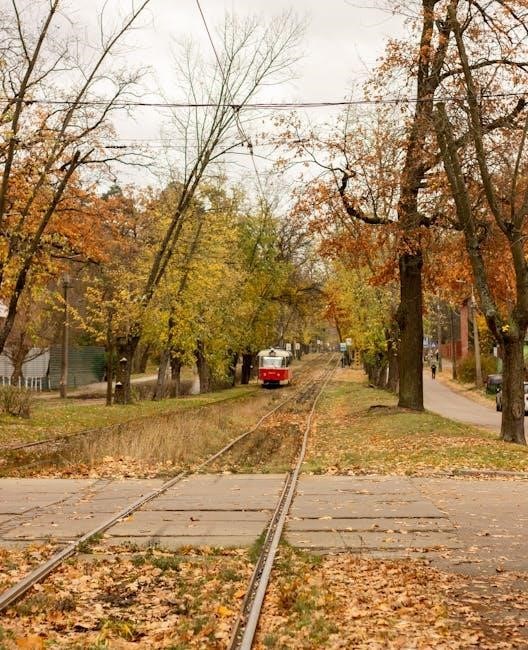“Monsters Are Due on Maple Street” is a gripping teleplay by Rod Serling, exploring fear, paranoia, and societal breakdown. The story, set on Maple Street, depicts residents reacting to an unknown threat, highlighting human vulnerability. The PDF version preserves this timeless tale, offering insights into its enduring relevance and themes.
1.1 Overview of the Story
The story unfolds on Maple Street, where a mysterious threat creates chaos. At 6:44 P.M., residents detect strange phenomena, sparking fear and paranoia. Charlie Farnsworth emerges as a leader, but suspicion grows among neighbors. The narrative explores how fear transforms a quiet community into a state of panic and distrust. The PDF version captures the essence of Rod Serling’s teleplay, highlighting the psychological breakdown and societal collapse when faced with the unknown, leaving a lasting commentary on human behavior under stress.
1.2 Historical Context and Relevance
Written during the Cold War era, “Monsters Are Due on Maple Street” reflects the societal fears of the time. The story resonated with audiences amid the Red Scare and McCarthyism, as it depicted a community gripped by paranoia and suspicion. The unknown threat symbolized the era’s anxieties about communism and the “other.” The PDF version preserves this historical narrative, offering insights into how fear and misinformation can destabilize society. Its relevance endures, as it continues to mirror contemporary concerns about mass hysteria and societal fragmentation.

1.3 The Significance of the PDF Version
The PDF version of “Monsters Are Due on Maple Street” serves as a vital resource for preserving the original teleplay. It maintains the integrity of Rod Serling’s script, ensuring that the story’s themes and historical context remain accessible. The digital format allows for widespread distribution, making it easier for modern audiences to engage with the material. Additionally, the PDF version facilitates scholarly analysis and educational use, providing a reliable source for understanding the play’s cultural and historical significance. Its availability ensures the story’s enduring impact across generations.
Literary Analysis of the Play
The play delves into fear, paranoia, and suspicion, illustrating how these elements escalate tensions and unravel social cohesion, reflecting human frailty under uncertainty.
2.1 Themes of Fear and Paranoia
The play masterfully explores how fear and paranoia escalate tensions, transforming ordinary neighbors into suspicious adversaries. The unknown threat on Maple Street triggers a chain reaction of distrust, as residents project their fears onto one another. This psychological unraveling highlights the fragility of human rationality and the dangers of unchecked paranoia. The story serves as a timeless cautionary tale about the destructive power of fear, resonating deeply with audiences even today.

2.2 The Role of Suspicion in Community Dynamics
Suspicion plays a pivotal role in unraveling the unity of Maple Street’s residents. As the unknown threat looms, neighbors turn on one another, fueled by mistrust and speculation. The story illustrates how suspicion, once embedded, spreads rapidly, eroding trust and fostering division. This breakdown in communication and cooperation highlights the destructive potential of unchecked suspicion, creating a toxic environment where fear dictates actions. The PDF version underscores this theme, showing how quickly societal bonds can fracture under pressure.
2.3 Symbolism in the Story
The story uses symbolism to convey deeper meanings, with Maple Street representing ordinary suburban life disrupted by the extraordinary. The “monsters” symbolize the unknown, tapping into primal fears of the unseen. The neighborhood’s transformation from tranquility to chaos mirrors societal breakdowns during crises. The PDF version highlights these symbols, emphasizing how fear and paranoia can escalate tensions. The characters’ actions symbolize the loss of rationality, while their suspicions reflect the fragility of trust. The story’s symbols remain timeless, resonating with universal human experiences.

The Plot Summary
On Maple Street, ordinary suburban life is disrupted by mysterious events, sparking fear and paranoia. Residents confront an unknown threat, leading to escalating tensions and chaos.
3.1 Setting: Maple Street and Its Residents
Maple Street is a quiet, suburban neighborhood where residents live ordinary lives. The story unfolds on a late September evening, capturing the street’s calm moments before chaos ensues. The setting highlights the contrast between peaceful suburban life and the impending unknown threat, emphasizing the vulnerability of the community. The residents, including families and individuals like Charlie Farnsworth, are portrayed as relatable and typical, making the unfolding events more relatable and tense.
3.2 The Arrival of the Unknown Threat
The story begins with a sense of normalcy on Maple Street, but an eerie pause signals the arrival of the unknown threat. At six-forty-four P.M., strange occurrences—lights flickering, machines shutting down—plunge the neighborhood into confusion; Residents, initially calm, grow uneasy as the unexplained events escalate. The once-peaceful street transforms into a scene of rising tension, setting the stage for fear and paranoia to unfold. This marks the turning point, shifting the community’s dynamics irreversibly.
3.3 The Climax and Its Aftermath
The climax unfolds as the neighborhood’s fear reaches a boiling point, with residents turning against each other in suspicion and panic. A tragic confrontation occurs when they mistakenly attack one of their own, believing him to be an alien. In the aftermath, the military arrives, revealing that the supposed “monsters” were humans from nearby Oak Street, manipulated by real aliens to destroy each other. The twist underscores the devastating consequences of fear and paranoia, leaving the community shattered and reflective.

Character Development
The story delves into the transformation of ordinary residents, revealing their vulnerabilities and fears. Charlie Farnsworth emerges as a key figure, embodying courage amidst chaos, while others succumb to paranoia.
4.1 The Role of Charlie Farnsworth
Charlie Farnsworth stands out as a pivotal character, initially showing courage and rationality. He attempts to unite the neighborhood, advocating for calm and logic. However, as paranoia intensifies, Charlie’s resolve crumbles, revealing his vulnerability. His transformation mirrors the community’s descent into chaos, highlighting the fragility of leadership under extreme duress. Through Charlie’s journey, the story underscores how fear can erode even the strongest among us, leading to devastating consequences for Maple Street.
4.2 The Transformation of the Neighborhood
The once peaceful Maple Street descends into chaos as fear and paranoia escalate. Neighbors, initially united, turn against each other, fueled by suspicion and dread. The streets, once filled with familiar faces, become a battleground of mistrust and hostility. The unknown threat looms, transforming the community’s camaraderie into bitter division. This stark shift from harmony to hysteria underscores the fragility of social bonds in the face of unrelenting fear, leaving Maple Street forever scarred by the events of that fateful evening.
4.3 Key Supporting Characters and Their Roles
Supporting characters like Steve and Mrs. Farnsworth play pivotal roles in “Monsters Are Due on Maple Street.” Steve embodies skepticism and reason, initially questioning the panic, while Mrs. Farnsworth represents fear and hysteria. Other neighbors, such as Charlie, showcase the spread of paranoia, highlighting how quickly mistrust can escalate. These characters illustrate the breakdown of social order, as fear drives them to turn on one another, ultimately revealing the destructive power of unchecked dread and suspicion within a once harmonious community.

Themes Explored in the Story
The story delves into themes of fear, paranoia, and mass hysteria, illustrating how societal order collapses under perceived threats, revealing humanity’s darker instincts and vulnerabilities.
5.1 The Nature of Human Fear
The story masterfully explores the irrational and primal nature of human fear, illustrating how it escalates into paranoia and hysteria. On Maple Street, fear of the unknown transforms neighbors into enemies, revealing the fragility of rational thought. The external threat amplifies latent anxieties, showcasing how fear can dismantle trust and unity. This theme resonates universally, highlighting humanity’s susceptibility to panic and the destructive power of unchecked fear, making it a timeless commentary on human psychology and societal behavior.
5.2 The Dangers of Mass Hysteria
The story vividly illustrates the dangers of mass hysteria, as fear of an unknown threat escalates into chaotic suspicion and violence. The neighbors, driven by irrational dread, turn on each other, demonstrating how quickly rationality crumbles under collective panic. This breakdown highlights the destructive power of unchecked fear, as ordinary people become complicit in their own downfall. The PDF version underscores this timeless warning, reminding readers of the fragility of social cohesion in the face of unverified terror and paranoia;
5.3 The Breakdown of Social Order

The story portrays the rapid disintegration of social order as fear and paranoia engulf Maple Street. Neighbors, once united, descend into chaos, mistrusting one another and abandoning civility. The collapse of social norms is stark, as rational behavior gives way to irrational violence and suspicion. This breakdown highlights how swiftly societal structures can crumble under fear’s grip, leaving individuals isolated and morally adrift. The PDF version underscores this theme, illustrating how fear can dismantle even the strongest communal bonds and lead to devastating fragmentation.
Cultural and Historical Significance

Created during a tense Cold War era, “Monsters Are Due on Maple Street” reflects societal anxieties and paranoia, offering timeless commentary on fear’s impact on communities and humanity.
6.1 The Cold War Era and Its Influence
The teleplay, crafted during the Cold War, reflects the era’s pervasive anxieties. The fear of an unknown threat mirrors the societal paranoia about communism and nuclear annihilation. The story’s exploration of how external dangers can fracture a community resonates with the McCarthyism and distrust prevalent at the time, highlighting how fear can lead to internal collapse and loss of rationality.
6.2 The Story’s Relevance in Modern Times
The themes of “Monsters Are Due on Maple Street” remain strikingly relevant today. The story’s exploration of fear, paranoia, and the breakdown of rationality resonates with modern societal challenges, such as misinformation, political polarization, and the rapid spread of anxiety through social media. The PDF version underscores how timeless the tale is, as contemporary audiences face similar struggles with trust and unity in the face of uncertainty, making the story a powerful cautionary tale for understanding human behavior in crises.
6.3 The Impact on Popular Culture
“Monsters Are Due on Maple Street” has left an indelible mark on popular culture, inspiring countless references in TV, film, and literature. Its exploration of paranoia and fear has influenced works like Stranger Things and The Walking Dead. The story’s timeless themes have cemented its status as a cultural touchstone, with its PDF version ensuring its ideas continue to reach new audiences. Its influence underscores the power of storytelling in reflecting and shaping societal anxieties, making it a enduring classic in modern media.
The Teleplay and Its Adaptations
Rod Serling’s teleplay has been widely adapted, with the PDF version preserving its original dialogue and structure. Its themes continue to resonate, ensuring its lasting impact.
7.1 The Original Teleplay by Rod Serling
Rod Serling’s original teleplay masterfully crafts tension through dialogue and setting. The PDF version captures his unique storytelling, blending social commentary with suspense. Serling’s work remains a landmark.
7.2 Adaptations and Interpretations Over Time
The story has been adapted into radio plays, stage productions, and modern interpretations, ensuring its timeless themes resonate across generations. The PDF version serves as a primary source for these adaptations, preserving Serling’s original vision. Over time, directors and audiences have reinterpreted the narrative, exploring its universal themes of fear and paranoia. Its enduring relevance is a testament to its ability to transcend mediums, offering fresh perspectives while maintaining its core message. This adaptability ensures its continued impact in contemporary storytelling.
7.3 The Role of the PDF Version in Preservation
The PDF version of “Monsters Are Due on Maple Street” plays a crucial role in preserving Rod Serling’s original teleplay. It ensures that the story’s integrity and historical context are maintained for future generations. The digital format allows easy access and distribution, safeguarding the narrative from physical degradation. Additionally, it serves as a reliable resource for scholars and enthusiasts, providing a clear and consistent reference point. This preservation effort is essential for understanding the cultural and historical significance of the story in modern times.

The Role of the Director and Cinematography
The director’s vision and cinematographic techniques in “Monsters Are Due on Maple Street” amplify tension through lighting and sound, creating a visually immersive and emotionally gripping experience.
8.1 The Vision of the Director
The director’s vision in “Monsters Are Due on Maple Street” masterfully translates the story’s tension and paranoia into visual form. Through strategic lighting, shadows, and camera angles, the director emphasizes the escalating fear and chaos among the characters. The cinematography captures the claustrophobic atmosphere of Maple Street, heightening the sense of dread as the unknown threat looms. This visual storytelling enhances the emotional impact, drawing viewers into the unfolding drama and its timeless themes of fear and societal breakdown.
8.2 Cinematographic Techniques Used
The cinematography in “Monsters Are Due on Maple Street” employs high-contrast lighting to create suspense and unease. Close-ups capture the fear in characters’ faces, while wide shots emphasize the isolation of Maple Street. Low-angle shots heighten the sense of vulnerability, and slow zooms build tension as the unknown threat approaches. Shadows are used to obscure potential dangers, creating a mysterious atmosphere. These techniques, combined with strategic camera movements, effectively convey the escalating paranoia and chaos, immersing viewers in the story’s tense and dramatic unfolding.
8.3 The Use of Lighting and Sound Effects
Lighting and sound effects in “Monsters Are Due on Maple Street” amplify tension and fear. High-contrast lighting creates dramatic shadows, obscuring potential threats. Sound effects, like eerie noises and unsettling silence, heighten the mysterious atmosphere. The absence of a visible enemy relies on these elements to evoke dread. Strategic use of sound, such as faint, unidentifiable hums, builds suspense without revealing the source. This combination of visual and auditory techniques immerses the audience in the escalating paranoia and fear gripping Maple Street.
The Music and Soundtrack
The music and soundtrack in “Monsters Are Due on Maple Street” use eerie tones and unsettling silence to build tension. The absence of a melody emphasizes the unknown threat, heightening suspense and immersing the audience in the unfolding paranoia.
9.1 The Importance of the Soundtrack
The soundtrack in “Monsters Are Due on Maple Street” plays a crucial role in enhancing the emotional impact and tension. By using minimalistic yet eerie tones, it amplifies the sense of unease and paranoia among the characters. The absence of a traditional melody allows the audience to focus on the dialogue and the escalating fear. This approach creates a haunting atmosphere, making the unknown threat feel even more menacing. The PDF version highlights how the soundtrack complements the story’s themes, ensuring its message resonates deeply with readers.
9.2 The Role of Music in Building Tension
Music in “Monsters Are Due on Maple Street” is a masterful tool for heightening suspense and mirroring the characters’ escalating fear. The minimalist score, often featuring sudden shifts in tempo and volume, creates an unsettling atmosphere. Eerie tones and pauses amplify the sense of dread, foreshadowing the unknown threat. The PDF version emphasizes how the soundtrack’s subtle yet powerful cues reflect the growing paranoia and chaos, making the audience feel the characters’ anxiety deeply. This auditory tension is pivotal in drawing viewers into the story’s gripping narrative.
9.3 The Composer’s Contribution
Composer Bernard Herrmann’s score for “Monsters Are Due on Maple Street” is a testament to his mastery of evoking emotion through music. His minimalist approach, using a small orchestra, creates a haunting atmosphere that complements the story’s tension. Sharp, jarring notes and unsettling silences mirror the characters’ growing paranoia. The PDF version highlights how Herrmann’s composition amplifies the psychological depth of the narrative, making the unknown threat feel ever-present. His work underscores the themes of fear and societal collapse, leaving a lasting impression on the viewer.
“Monsters Are Due on Maple Street” remains a timeless allegory of fear and paranoia, its PDF preserving universal themes for future generations to study.
10.1 The Lasting Legacy of the Story
The story’s legacy endures as a profound commentary on human nature. Its exploration of fear and paranoia remains relevant, influencing literature, film, and popular culture. The PDF version ensures accessibility, preserving Serling’s timeless message for future generations to reflect on societal vulnerabilities and the dangers of mass hysteria. Its impact continues to resonate, making it a cornerstone of cultural discourse and a reminder of the universal themes it embodies.
10.2 The Universal Appeal of the Themes
The story’s themes of fear, paranoia, and societal collapse transcend time and culture, resonating universally. Its exploration of human vulnerability and mass hysteria speaks to fundamental emotions, making it relatable across generations. The PDF version ensures these themes remain accessible, preserving their relevance. The universal appeal lies in its ability to mirror human behavior during crises, highlighting the fragility of social cohesion and the dangers of unchecked fear, ensuring its enduring impact on readers worldwide.
10.3 The Importance of Reflecting on the Story’s Message
Reflecting on the story’s message is crucial for understanding its timeless relevance. It challenges readers to examine their own reactions to fear and uncertainty, fostering empathy and self-awareness. The PDF version ensures accessibility, allowing deeper analysis of how societal anxieties can escalate into chaos. By exploring these themes, audiences gain insights into human frailty and the importance of rationality in crises. The story’s message remains a powerful reminder of the dangers of fear-driven behavior and the need for unity.
